Some games I played in
2019
I didn't set out to review what I played the past three years, only having enough opinions to fill a blog post. I'd intended to do the same this year... but then it got a trifle bloated to cram into the blog, so here we are!
Resident Evil: The Mercenaries 3D |
Nintendo 3DS Jan |
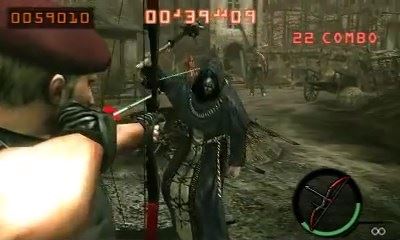
I'm such a sucker for the Mercenaries mode in Resident Evil 5 that this was my first ever 3DS purchase... and then it took me years to actually have the patience to play it. I hated the Circle Pad...! The game uses the same controls as RE4 and 5, which hardly needed analogue precision. The D-Pad's right there!! There's no option to swap them, but I eventually got acquainted with it.
It's a strain on the thumb during long sessions and nowhere near as precise as a D-Pad, but it does eliminate the need for a run button, which makes the game so much zippier. I tried going back to RE5 after this, and the movement controls alone were enough to throw me off my game entirely. I prided myself on those skills...!
The game divides itself into 'missions', basically various degrees of difficulty across the ten maps, and it takes a little while before it starts providing a decent challenge, but it's the same Mercenaries as ever - kill all the dudes in the time limit, use melee attacks for time bonuses, and use time extensions and combo multiplier totems wisely. Getting S-Ranks will unlock new characters and costumes, all with their own unique loadouts and play styles, which can really change how you approach the game. Barry's big on heavy-hitting magnums and shotguns, but his limited ammo capacity forces you to make use of melee strikes to get the job done.
It's a great game to dive into for a quick session, though it's hard to just settle for one match - I always need to warm up before I get into my groove! That, and it's easy to think, "five minutes will do," but by the game's very nature of time extensions, what you thought would be a quick match can easily stretch out to over 20 minutes! It's not a game you can set your watch by, unlike my other 3DS fallbacks like Mario Kart or Pokémon Rumble.

I spent the start of this year getting all SS-Ranks with Rebecca, whose armoury of grenade launchers instantly paralyses all enemies, allowing you to melee them into oblivion. She's clearly the game's easy mode, making it all the more confusing that you have to unlock her. It's a somewhat brainless fighting style, but it's easier to pick up and play in new sessions - I needed to work on my rhythm with the likes of Claire or Wesker before I could clear mobs with them.
The game was likely a cheap little experiment for Capcom, an excuse to release something quick and dirty for the 3DS' lousy launch window, but it's something I'd like to see more of. I respect survival horror yet have very little personal interest in playing them, but these arcade score-attack games are right up my alley.
If I had to grumble, I wish Sheva was in it. I liked her! That, and it'd probably offset the fact you spend the first hour of the game shooting innocuous black villagers before it even introduces proper-ass mutants and monsters. Not to bang an old drum, but it's a bit more awkward this time around when there's no context given and the player roster is 100% white dudes...!
Meow Motors |
PC (Steam) Jan |
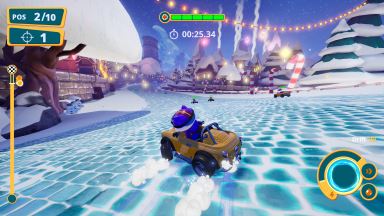
CATS! WITH!! CARS!!! A fuzzy multi-player kart racer with a cast of cute kitties and a campaign mode boasting over a dozen unique tracks and three types of challenge to face. My brother's mad about racers and is eager to try whatever new one comes out, and I'll occasionally take a peek in his Steam library to see what's up. I confess it's very rare that a racing game truly 'clicks' with me - it doesn't help that F-Zero GX still remains my gold standard - but Meow Motors feels just right, and carves its own niche for good measure.
The game's big unique feature is its all-purpose metre, that's filled up by either attacking enemies or performing sweet drifts. That metre can then be spent on speed boosts or oil slicks, to keep yourself ahead and your opponents behind respectively. Races typically feature everyone clustered together, as if by design - you're either in the thick of it or just scraping ahead. Scoring a multi-hit combo to earn yourself enough boost to sail ahead of the pack feels really sensational, and even in first place you can't rest on your laurels - having opponents slip on your oil slick also recharges your metre, allowing you to boost further ahead or lay more traps for them.
It's a very different system than most kart racers and takes a little while to cotton on to, but once I did, it makes for a really engaging system. The only time it falters is when you're in dead last and far behind the pack - without targets to attack, clawing your way back and filling your boost gauge feels almost impossible.
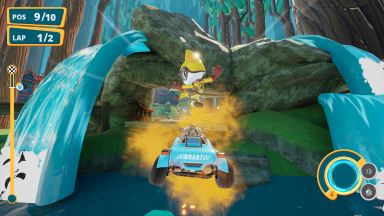
The campaign mode pits you against the various play modes - race, time trial, drift challenge, battle, etc. - and along the way you unlock new items, cars and character. Each of them adds something new to the metagame; each new item can really change how war is waged, while every cat has their own perk, like better traction off-road or even the ability to randomly null all damage.
You replay the same courses constantly throughout the campaign, but it feels rewarding to progress and to do better to unlock these extras... though by the game's end it makes replaying old stages a bit of a slog. There's so many varieties of item that races just become a bit of a clusterfuck. Free play mode gives you the option to can toggle items on and off, at least.
It takes a little while to adjust to the game's unique flow or its quirky drift mechanic, but I had an absolute blast. It looks sharp, it plays superb, and the cats really are adorable. I blazed through the game in only two days, I couldn't put it down! ... though now I'm reluctant to pick it up again, having mastered everything there is to do. The game is sadly lacking an online multi-player function, which would have given it a lot more lasting value.
Transformers: Titans Return |
TV (YouTube) Jan |

I watched Transformers: Combiner Wars the year before, a Machinima production that served as a belated tie-in to the toyline. I'm a self-confessed Transformers pleb who'll choke down anything even remotely flavoured like car-robots, and I think the novelty of 3D animated adventures loosely inspired by the IDW comics had me sludging through it, no matter how badly written or poorly paced.
I had no reason to believe this one would be better. Boy, it ain't great! Nearly two hours of 'story' and 'action' that has no right to be two hours long. Action that feels tepid and weightless. Scenes that drag on or don't flow well. Arcs that seemingly go nowhere and characters that do nothing. I could go on. You'd think Optimus and Megatron teaming up to defeat Starscream's ghost that's possessing the city-sized dinosaur Trypticon should be charmingly brainless entertainment... but not really, no.
I have to ask myself: What is good about it? Oof. Let's make a list.
Perceptor and the Mistress of Flame are fun in their roles as city defenders; at least, her reliance on divine intervention and his belief in scientific analysis should make for amusing byplay, but it rarely happens. Then the Mistress gets fridged and Perceptor is left with no one to bounce off of.
Megatron does nothing but lounge around and snark at people, which is easily the best part of the entire series so far.
Menasor being portrayed as a giant idiot is about the closest any of the combiners have gotten a hint of personality.
Overlord's country bumpkin attitude should be endearing in theory, but the son of a bitch does nothing besides deprive us of potentially interesting characters, and one of those actions doesn't even pay off until the next series.
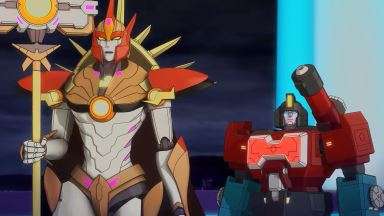
The series is clearly made on a budget, one it seems to spend on unexpected voice actors (Wil Wheaton?! Michael Dorn?!?), and it's just frustrating it doesn't come together into a tighter, more cohesive package. It's hard to get invested when the stakes seem to shift from episode to episode - in some, Trypticon is unfazeable, in others Prime's blaster is able to bring him to his knees... and ultimately he's not even killed by the heroes, but Starscream's ghost ejecting his body.
I'm a dope who tries to rationalise all the bad media from a franchise I like, trying to find some redeeming takeaway from having endured through it. There's some nuggets of fun characterisation you can almost take away from this, but I would not recommend watching it, unless you're doomed to to being invested in pap like I am.
EX Troopers |
PlayStation 3 Jan ~ unfinished |

I'd been wanting to play this for years; this was the one gap in my admittance to being a total Lost Planet nut. I'd played all five games (including the two mobile games!), bought the shirt, and read the absolutely worthless prequel comic (here's hoping the rare-as-balls manga is better, if anyone ever shares it, welp). This game was released only in Japan on the 3DS and PS3 - the 3DS is region-locked, and the digital version on PSN is still at full price... so I just imported the disc version for the equivalent of Ł3.
The game's a lot more simplified since Lost Planet 2, but it introduces some fun changes that make for faster, more kinetic gameplay. Characters are now equipped with Arbiters, booster packs that allow them to dash in every direction; the game is strictly ground-bound, but it adds a bit of anime flair to the art of dodging. Staples like the Anchor and grenades are gone, but there's been a slow drip of new features so far, including bombastic melee attacks that can launch dudes into the air, and some sort of special move I've since forgotten how to use. I haven't even gotten to the mechs yet...!
Missions are compact and bite-sized, offering quick challenges intended to be replayed for score and achievements, and your hub base offers a variety of story missions, challenges, or VR lobbies to play alone or online with pals. It's very nifty and clearly designed for zippy pick-up-and-play sessions, something that'd fit very nicely on a handheld... and all the more disappointing I'm playing it on my croaky, disc-chugging PS3.
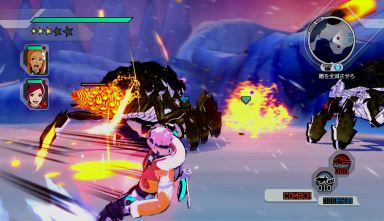
When I last left off I was just after moving to the second larger base; I haven't been able to follow the story in depth, the whole game being in Japanese, and I still think I'm missing a few of the vital commands, but the game has a built-in manual that I can probably parse if I sound out the katakana until it makes sense.
For such a cheap purchase (I might end up getting the digital version if just to save my PS3's dying disc drive the effort) I've been very pleased, and seeing Lost Planet adapted into something zippier and flashier is a blast to see. It is a bummer the game is so pared down in features, but I'm sure for a handheld it was perfectly suitable. I include this more as a reminder to myself to play the game again! I'd like to look up some English resources (or make them if nobody else has, ooer), but even the language barrier shouldn't stop you from enjoying this if the first two Lost Planets struck your fancy.
Transformers: Power of the Primes |
TV (YouTube) Jan |

I made it this far, I figured I'd put the trilogy behind me. There's the dire temptation to recap it all for Random Action Hour, but I've zero incentive to rewatch the series otherwise.
So Titans Return ends with Megatronus (aka The Fallen, one of the ancient bastards from Cybertronian pre-history) showing up for some reason and killing Optimus Prime, as you do. He wants to extinguish all life in the universe to bring back his dead love, Solus Prime. With Optimus dead, Megatron is enlisted to lead the Autobot party into the swamp to fetch their macguffin, and a bunch of pointless fight scenes ensue.
After keeping you waiting from the last series, none of the dangling threads are followed up in a satisfying manner. Rodimus has been corrupted with the Matrix of Chaos, which invokes the spirit of Unicron! All this does is make him Overlord's silent underling for the whole series, until he starts feuding with him over the Matrix of Leadership. Hell, Overlord's feud with Megatron is barely fleshed out either, and then he's wiped off the map with the Requiem Blaster.
Characters are killed off with barely any notice, including all the combiners, and new characters get shockingly little to do. Grimlock and the Dinobots are here! They accomplish bugger-all. Predaking shows up in two episodes and dies unceremoniously. Optimus Primal gets a lot of screentime but is practically a cipher, an expressionless guardian sealed away from the rest of the world. What a waste of a good character - they got Ron Perlman in for this!?

Once again I ask myself: what's good about it?
Mark Hamill steals the show as Megatronus, delivering a suitably slimy and sanctimonious voice for the villain. It's hard to get invested in him as a character, mind, but the voice sells it.
As the only major combiner, Victorion finally gets a chance to stand her own and is presented as a valourous if overly-wordy knight-like character, making for fun contrast with the brash Dinobots.
The partnership between Overlord and Rodimus Cron is kind of interesting, if only because Overlord is oblivious that the essence of Unicorn is what's really possessing his minion. Unwittingly recruited the devil as your gofer should be a barrel of laughs, but the two contribute shockingly little.
The series ends with untold amounts of Cybertronians dead, yet we're given hopeful endings for the surviving cast... but the worldview has been so minute that it's kind of meaningless. Cybertron might as well be a ghost town!
With Rodimus crippled after Unicron's possession, Optimus stepping down and Primal now the Matrix-bearer, who only now is introduced to Cybertronian society, having spent his whole life in waiting as a secret weapon... the series ends on what could almost be an interesting new status quo. Starscream's ghost even appears for a last-minute sequel tease... that's immediately undone by it saying "the end". There's a lot of angles you could take these admittedly iffy ideas, and the series decides on none of them.
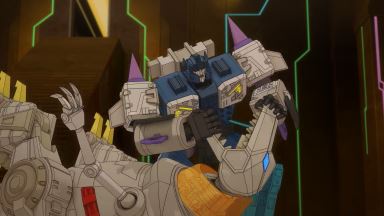
Its episode-by-episode flow feels a little bit sharper than the last two series... though I watched this one on 1.5 speed and it was more tolerable for it. I'd argue the first series felt the most fleshed out, if just because it had some idea of scale with its various factions... it's just frustrating it took them two years to finally work out how to plot a story slightly better, only to spend it all in the most boring and dingy of environments.
Please let me write about Transformers media I earnestly enjoy!
Celeste |
PC (Steam) Jan |

Borrowed this from my brother's Steam library on a whim. I'm rarely a fan of hard-as-balls twitch-reaction platformers along this vein, but I must have heard enough good things to justify giving it a shot.
It's about what you'd expect, gameplay-wise. You scale mountains using your air-dash and climbing abilities, with level-specific gimmickry that keeps you on your toes. It gets pretty intense later on, but its use of pacing and storytelling does a great job leveling out these spikes in heart rate; there's always some form of cooling off without having to outright pause the game.
I'm honestly not sure if the game was my cup of tea; it was the story and themes that kept me going. Madeline's journey is framed as a search for... something. To face her fears, to find inner peace, to have accomplished something for once in her life. Something! It's a big todo about mental health; her attitude is often messy and vitriolic, but often simply because she's out of her depth and doesn't know the answers. That's life! You want these characters to do well, but it's never as easy as just fulfilling a video game-like goal - getting better is a process.

I found it tied in with the game itself very well - fighting to overcome problems and trying again and again, no matter how often you fail. When games try for positive reinforcement it tends to come across as condescending, offering textual platitudes you're already aware of instead of cutting you a break.
In Celeste, the themes resonate closely with the game itself: just as much as I threw myself at challenges again and again, screwing up and doing it the wrong way, Madeline barely drags herself through each chapter, and fights with herself over to have hope in making it this far, or chiding herself for putting up with such a stupid quest. As someone still unsure if this game was even for me, that's unwittingly relatable!
I got somewhat into the game by its end and even completed two or three of the hardcore secret challenge levels. I don't know if it's a game I'd want to replay, but its sweet setting and characters really made such a difference, and that idea of positive reinforcement warmed me to the idea of exploring this sub-genre of platformer more. Even its options are accommodating to all skillsets, with the ability to disable stamina or even reduce the game speed; I never used it myself, if only because it requires you to quit out of the stage and apply it on the main menu, so it can't be used as a quick fix in a moment of frustration. Still, a welcome addition I'd like to see more often. Look what happens when you're welcoming, huh?
Mineirinho Ultra Adventures |
PC (Steam) Jan ~ unfinished |
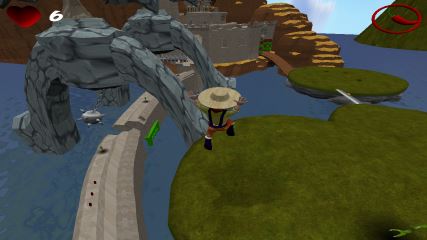
RQ87 gifted this to me years ago, and foolish me thought it was some 3D indie collect-a-thon in the vein of Banjo-Kazooie. Hahaha. Foolish mortal. It's instead an extremely janky get-to-the-goal platformer with enormous, sprawling, completely aimless levels, and a goal buried in some obtuse location you'd never think of going.
I'm always intrigued by early indie games, and this was from before the rise of Unity, which really opened access to 3D game development for folks without access to proper coding tools or devkits. Having worked with and played a ton of games made in programs like The Games Factory of Clickteam Fusion, I've some awareness of how tricky it is to even make something that simply works; to make it good is a whole other endeavour.
But it's fascinating seeing the old fangame design philosophies carried over to this 3D monstrosity. Throwing bizarre platforming challenges at a moment's notice. Obtuse power-ups that are rarely seen again. Extended gimmick levels that wear out their welcome fast... and that's before you have to replay them a few dozen times because there's frequent death traps and absolutely no checkpoints!
Every couple of months I bang my head against it for a bit in hopes of seeing a little more. The first level took a few dozen attempts, but I've got down pat. The second level I barely finished after literal months of attempts. My first time exploring the third level, I hugged the boundary a little too closely and fell out of world, with no means of resetting. I've already watched the SDGQ run so I've a rough idea of what's ahead, but it's making it there on my own that's the real appeal. I'm in no rush, though.
Transformers: Devastation |
PlayStation 3 Feb |

I picked this up when I got Transformers: Rise of the Dark Spark on the going-away-forever sale, and I'd reason to believe this one might actually be good. It's by Platinum Games, so you know what that means - dynamic, melee-centric character action! Optimus Prime and the boys scrap across Earth and Cybertron to stop some ridiculous Decepticon scheme, employing ludicrous weaponry, meaty comboes, and their own vehicle modes as blunt instruments to ram, sideswipe, or flatten their opponents.
I've never actually played a Platinum Games title before, so this was my first time. It takes a while to get into the flow of things, especially when vital manoeuvres like parrying and counters are locked behind the shop menu for some baffling reason, but once I got acquainted with it, I was able to wreck loose with all the characters. So few games have truly satisfying combat, but being able to juggle a crowd of foes by zipping between them with melee strikes and vehicular ramming is so much fun to pull off on the reg.
The game has buttloads of weapons, both melee and firearms, all with random add-ons, such as elemental damage, buffs, and a variety of stats. Mixing and matching play styles is fun to figure out, though it is a little bit ridiculous, especially when each character already has their own set of stats you can upgrade.
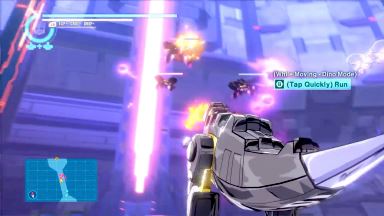
The weapons are explicitly designed to be disposable or even combined together to get the best of all their traits. It's an interesting system and is fun to play around with on the side, but when you have to weed out the trash every time your inventory is full, that's when it gets tiresome. Can't I just pick favourites and let it auto-recycle the rest...?
While the game does juggle melee and gunplay, allowing you to whip out a firearm and enter an over-the-shoulder aiming mode at any moment, it's clear it favours fisticuffs most of all. Understandably, given that's Platinum's forte and all. It is fun to use the guns and find ways to work them into combat, but when they're mandatory to progress, be it shooting targets out of the air or using ungainly rocket or grenade launchers, you can see why they're not the main focus. That, and their ammo is so sparing you're not encouraged to enter every battle guns-blazing.
It's neat that they're included, though, and even better that they're somewhat practical. The Japan-only Transformers game on PS2 featured absolutely diabolical gunplay, and its melee combat was hardly up to snuff either. This leaves it in the dirt, though you are missing out on that game's charming voice acting and deep-dive fanservice.
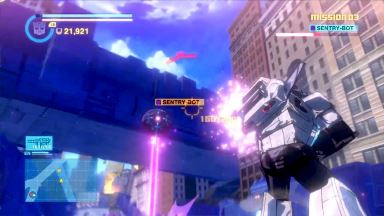
Devastation looks pretty sharp; it's so nice to have a Transformers game with colour in it! It's also the first game to give the full HD treatment to the Generation One cartoon aesthetic, and as tired as the throwbacks and homages to the old show may be, I won't deny it tickles me. Seeing Sideswipe finally do something for once in his goddamned life is novelty enough, and playing up Blitzwing like an actual threat is a long time coming.
The writing is basic cartoon fare with some lore from the IDW comics mixed in to spice things up. There's some funny dialogue, particularly from Wheeljack, voiced to perfection by Christopher Swindle, though I'd argue the characterisation is a bit 'off' at times. Bumblebee's role seems to be the snarky, sarcastic sidekick, while some of Wheeljack's funnier comments are admittedly a bit out-of-character for the kooky ol' scientist. Peter Cullen is good as always in the role of Optimus, though I have to pine for him - he never gets anything fun to say anymore! We're unlikely to get dopey lines like this from him again.

It's an incredibly fun game. It's clear it hasn't got the biggest budget - the campaign is less than ten chapters long, can probably be finished in 3 to 4 hours, and it revisits the same locations frequently, but I think it's the perfect length. Platinum design their games to be replayed and mastered, and getting perfect S-ranks across all difficulties is bound to keep me busy, not to mention the mission mode that I've yet to explore in-depth.
I admit my personal idea of the so-called perfect Transformers game is a lot different from what this delivers... but I have to confess it's probably the best game we've got so far. The Armada game on PS2 and even Revenge of the Fallen on Xbox 360 I got enjoyment from, but all aspects they succeeded in, there's still a lot of foibles and nitpicking to be had. Based purely on what Transformers: Devastation sets out to do, it accomplishes it with gusto, and makes for a short, sweet, but very robust package. I'd recommend it if the game hadn't been delisted for three years by now. Ugh.
Sonic & Sega All-Stars Racing DS |
Nintendo DS Feb |
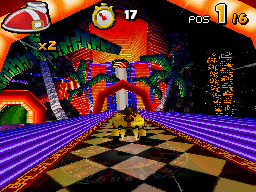
Because I haven't played enough of Sumo Digital's racers, apparently. A relatively solid conversion of the game to the dinky little handheld, and a surprisingly accurate one - it's barely missing a drop of content! All the racers are there, all the courses are present, and even the extra modes and SEGA Miles make the conversion.
What incentive is there to play this if you've already played it on consoles? The novelty, for one, though it does offer a unique challenge with its slightly different drift mechanic, and boasting a surprisingly brutal challenge in its expert Grand Prix. Mission Mode is almost completely different, boasting a huge assortment of challenges with a new ranking system, with lots of drift challenges. target practise and more; they're not too difficult, but getting perfect 10s might occupy you a while.
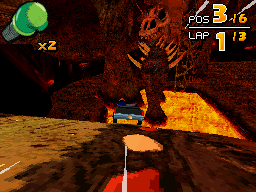
It does double-down on the original game's faults, though. Visibility stinks because the camera s often positioned so low it's hard to see what lies behind mild inclines, and the Curien Mansion stages are so dark you literally can't see incoming bends.
It's probably a quirk of the conversion process, but stages almost feel too big at times, as if they weren't scaled to match the new engine? Courses take 5 minutes to complete on average, which is a trifle long for a kart racer - the same course would take 3 and a half minutes on console. It's a feat that courses this big could be packaged onto a handheld, but make it snappy, buddy!
I came to this because I'd already blitzed Mario Kart DS and Diddy Kong Racing DS, and needed something to play on the go (or on the shitter). It's a little less slick in comparison to its console version, but it's not a bad effort. I'd argue those two still beat it out, if just for having more precise mechanics to master and more modes of play... but if you've played them to death already, then this'll tide you over.
Spikeout: Battlestreet |
Xbox Mar ~ unfinished |
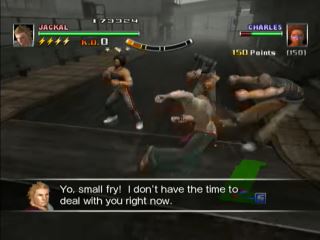
Bashed my head against this for a few weeks. A notoriously tough 3D beat-em-up from a series that was otherwise arcade-exclusive. It's got a mean barrier of entry - not only is the difficulty tough by default, there's no mid-level continues in the story mode, and the controls are so gonzo I spent my first session just bouncing between the control configuration and training mode trying to set something that felt remotely practical. It is not nearly as pick-up-and-play as Streets of Rage.
Once I got into it, I had a fun time. There's a fun rhythm and flow to the combat, and learning the properties of your moves to best effect is satisfying when you can keep a mob of baddies at bay. It's high risk, high reward, and you get punished hard when you whiff. As always with beat-em-ups, it's hard to tell the difference between smart tactics or just cheesing out patterns, but baddies have a good way of launching surprise attacks. You can't just rest on your laurels, even when it looks like you've got a good thing going on.
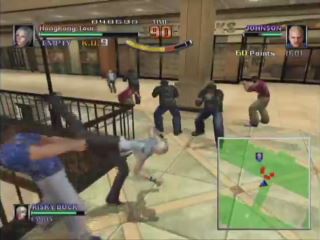
The game's got an intriguing story and setting, with a huge roster of characters you can unlock... but its story directly follows up its arcade-only predecessors, meaning there's zero context for anything. That's par for the course for beat-em-ups, mind.
I did beat the game on Easy in arcade mode using Fiona, but your character is predetermined in story mode, meaning I had to get reacquainted with new movesets every mission. Because of that - and because it's very long and very tough! - I've still yet to beat mission 3. I would like to see it through, but it's very unforgiving. This isn't a game you can credit-feed, you have to well and truly learn it if you want to get anywhere.
Mega Man Legacy Collection |
Nintendo 3DS Apr? ~ unfinished |

Yet another of my earliest 3DS purchases, because the Mega Man games are good to have on the go... if I hadn't played them all to death already! It would've been nice to have Mega Man 7 and 8 like its big boy versions, as I'm not nearly as acquainted with those instalments, but it doesn't, so that sucks.
I instead found myself finally diving into the challenge mode, which dumps you into a bunch of random quickfire segments from the six games; boss rushes, platforming challenges, or even a variety of setpieces from multiple games all in a row.
It's a refreshing little mix-up, a chance to embrace the likes of Wily's fortress stages or bosses without all the boring bits leading up to them. Replaying challenges to get the best time is pretty fun, especially when some boss fights insist on you exploiting weaknesses in record time to make gold.
It's a fun bonus to an otherwise just-what-you'd-expect compilation, though the challenges repeat so often and are unlocked so slowly (and even the list scrolls like molasses...!) that even they wore out their welcome a bit. I'll nip in now and then, but there's only so many times I can replay Quick Man's laser hallway before I wonder what the point is anymore.
Turok |
PlayStation 3 Apr |
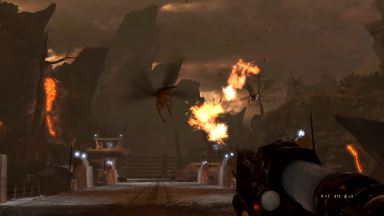
Picked this up for cheap from CEX because curiosity finally overtook me.
It's exactly what I expected - a generic military shooter with nigh-inconsequential dinosaur encounters. There's some neat setpieces and mechanics, betraying a faint glimmer of promise buried within the game... but it simply doesn't do anything to make itself stand out from the crowd, or serve as a worthy successor to its N64 forefathers.
Oh, and the multi-player has long since expired, so I can't even count on that as a saving grace. I can't argue given the price I paid, but I wanna see Turok done justice, y'know?
Donkey Kong 64 |
Nintendo 64 May |

Whenever I get a debilitating flu, my first thought is what otherwise impenetrable game can I bash my head against when I'm too unwell to know common sense. This year it was Donkey Kong 64, and I wrote a big dumb post about it already.
It was good to finally see the game in full, and it put me in a Donkey Kong mood that introduced me to some lovely fan art, but I'd struggle to say the game was actually entertaining. Your mileage may vary!
Banjo-Kazooie |
Xbox 360 May ~ Jun |
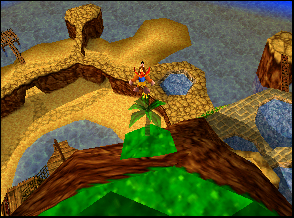
I wanted to make sure I still enjoyed collect-a-thons! Admittedly replaying this is hardly genre-affirming - I'm still nostalgic as heck for it and I think it holds up very well. Its levels are sprawling and have so much packed into them, but are rarely so huge I get lost in them. The music and graphics are bouncy and fun, and everything's so full of character - even if that character is almost invariably "snarky wiseass".
It's not as immediately replayable as Super Mario 64 in my books, which has yet to be topped in that department, and I tend to peter out by the third level on most playthroughs - partly because Clanker's Cavern still creeps the dickens out of me (the N64 did a number on my fear of water levels!), and also because by that point, exploring Gruntilda's lair becomes a full-time job. I forgot just how labyrinthine it got at times, and I spent entire sessions wandering around aimlessly trying to find where to go next.

It's a logical extension of Peach's castle in SM64 and adds a lot to the game's character, with its terrain and architecture literally emblazoned in monstrous imagery, not to mention Gruntilda insulting you the whole time. It makes the villain stick in your mind and appear more of a threat, even if you only see her at the beginning and end (and the game over screen). Compare that to Bowser, who gets his ass kicked twice before you're even halfway through the game and barely even changes tactics, and looks a right tosser because of it.
Banjo-Tooie would up the ante by having worlds interact with one another - passages that can only be opened from one side, characters whose fetch quests take place in a whole other level... it makes for a more robust and open-scope game, though there's something to be said for Banjo-Kazooie setting its sights small. Every level can be finished on the first go if you're thorough enough, as you never learn an ability that's required in an older level. It makes the worlds feel smaller in comparison to its sequel, but I like how zippy and self-contained everything is.
The Red Star |
PlayStation 3 Jun ~ unfinished |
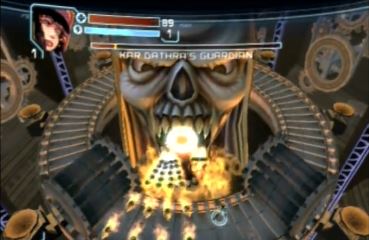
One of my unexpected favourite games on the PlayStation 2, and one I've wanted to properly play to completion with all characters and do it justice. I... I couldn't reach the final stage. It's too hard. My skills have slackened in the ten years since I last played it.
A top-down shooter crossed with a beat-em-up; shoot dudes with your three guns, or clobber them up-close with a variety of dashes, throws, launchers and slams, which also charges your special move metre. The three characters all have extremely different movesets, demanding a very different approach to the game, but they're all extremely kinetic and entertaining. I'd only played the game with Makita before, who's able to exploit her dashes, backflips and aerial attacks to zip across the battlefield or even avoid incoming bullets entirely.
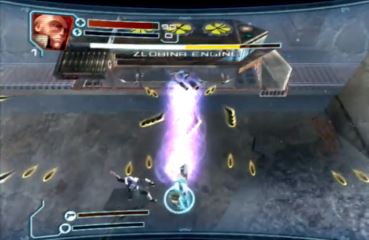
Kyuzo is a much bigger and slower target, but his long ranged spear gives him a huge knockdown game, able to impale baddies and launch them at others, then stomp them on the ground; and once he's full on special, launch a giant laser at the other side of the screen.
This was my first time even playing as him, and although losing Makita's evasive manoeuvres is a huge loss, it's so refreshing playing all the challenges in a whole new light. The third character, Maya, is only unlocked after beating the game, and unless I can salvage it from my PS2 memory card, I don't know when I'll get the chance to try her out...!
It's a bummer the PSN version is the only rerelease the game has seen; I'd love for it to get a new lease on life, though I'd also wish for it to get a few tweaks. The game is very influenced by arcade games, so much so that there's absolutely no level select. You can save your progress, but there's no way to replay and master certain stages without starting a new file and playing all the way there. It's a game I want more incentive to get acquainted with, but even if you're coming back to it after a long time away, you need to bring your A-game if you're picking up where you left off...! Still, absolutely recommended though.
Transformers: Decepticons |
Nintendo DS Jul ~ Aug |
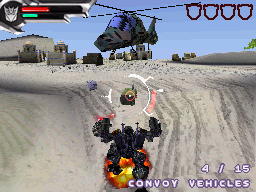
A vaguely open-world game based loosely on the 2007 movie, viewed through the eyes of a rookie Decepticon who's alternately aiding in the search for the Allspark and trying to diffuse or contribute to various uprisings among the ranks. You run around causing mayhem, scanning new alt-modes from passing vehicles, and partaking in story missions or score-attack rampages. The comparisons to Grand Theft Auto are hard to avoid!
The basic premise is charming enough. When you're not on a mission you've got the freedom to dick about at your leisure; in addition to transforming between vehicle and robot, you can pick up trees, cars and lampposts to use as blunt objects or projectiles, or wreck stuff with lasers and rockets. Causing mayhem gets the police and Autobots on your tail, and destroying them earns you XP that slowly unlocks new abilities - more manoeuvrability options, new guns or special attacks, and so forth. When there's no objective it gets pretty brainless, but the sheer novelty of running around as a transforming robot is entertaining.
The missions consist of tired staples like driving to waypoints, beating up baddies, defending the target until time runs out... they're extremely "licensed game". Some of them put you in control of your fellow Decepticons such as Brawl or Starscream, and using their unique movesets is a perk, but they're few and far between. The missions are busywork at best and imfeasibly difficult at worst. It practically devolves into luck of the draw in later stages, where whether you win or lose hinges entirely on an enemy dropping a random health refill.

I could live with the boring missions if combat were worthwhile, but even it's extremely brainless - burning through your ammo, then using melee until your lasers recharge and repeat. Some of the bosses attempt to mitigate this by being immune to one form of attack, and employ special moves that close the distance between you and them... but then it just boils down to finding their pattern and exploiting it to hell and back. Little sticking points in the controls, like how you lose all momentum when you exit from shooting mode, are enough time for you to eat a few hits that can potentially ruin your chances of survival.
Okay, so the combat sucks and the missions are lacking. Surely just being a car will make up for it...? Sadly, despite the long list of vehicles you can unlock, most of them play almost identically, consisting primarily of texture-swapped cars and vans. You do get a helicopter once you reach Qatar, and the brief instances you play as Starscream gives you access to his jet mode, but apparently it can only be unlocked via WiFi connectivity, a feature that's almost assuredly dead. While it is fun to get to grips with the cars' sharp turning, they don't control nearly as well as in a traditional racing game, and there's no thrills to be had by jumping off of ramps or anything. Your wheels are firmly on the ground at all times.
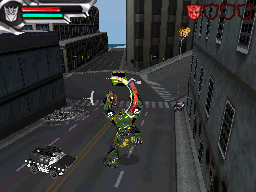
If nothing else, the story is fun to follow is just for its full voice acting accompaniment, with big names like Keith David and Steve Blum doing the legwork. I'm always a sucker for seeing the Transformers movie universe expanded in any way possible. Blackout isn't just a cool setpiece to kick off the first movie, he's an actual character! Barricade serves as the surrogate leader when Megatron and Starscream aren't calling the shots, and although it's lightweight fare, any hint of flavour from these guys is an appreciated gesture. Even Frank Welker busting out his classic Megatron voice as he blows his own ranks into chunks is a pleasure to hear.
When I needed a break from brainless work, it was nice to have a brainless game like this to veg' out to, though I wouldn't be in a rush to recommend it. It's big on novelty, but there's no real meat to sink your teeth into; no intricate mechanics to master or secrets to find. After Transformers: Devastation, it's a harsh reminder that most tie-in games aren't great. Its large open world is impressive for the DS, though it bursts at the seams with slowdown and graphical glitches in later stages... and there's simply not enough going on to make it worthwhile.
Chocobo Racing |
PlayStation Portable Jul |
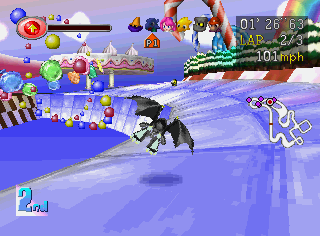
I have distinct, colourful memories of the few racing games I had on Nintendo 64, but all the ones I had on the PlayStation just kind of passed me by. I enjoyed this for its theme and aesthetic, and would replay through the story occasionally, but it was otherwise just a curiosity at best. Have I been missing out on a hidden gem this whole time? (probably not, the SquareSoft nuts would've made sure to shout it to the world)
It's a Chocobo-themed kart racer! It's viciously adorable and also plays pretty solid; I'd spent years playing the game by banging into every wall, but it's a lot more manageable once you get acquainted to the drift mechanic - which is to say, don't drift. Just tap the brake button! A single tap increases your turning radius drastically, and there's no risk of spinning out.
The item system is perhaps the game's most interesting mechanic: you can carry three items at a time, towing them behind you in the order they'll be used, or you can collect the same item up to three times to power up its effect. On top of that, you choose a Stone at the start of each race which can be used at any time once its auto-filling gauge is full.
It adds a nice bit of strategy to the game, and lets you determine what your play style will be before the race begins - do I take Dash and simply blaze ahead of the competition? Do I want to play defensively and keep Protect on hand? Or am I going to use Magic Up, powering up every item to maximum efficiency before I wreak havoc? They both add some spice to gameplay, and being able to carry multiple items makes botching an upgrade less of a blow than it is is in Diddy Kong Racing.
The game's starring mode is probably its story campaign, introducing all the characters, Stones and courses across various cutesy storybook cutscenes - it's total kiddy fluff, but there's some fun dialogue in there from Moogle. It's a glorified tutorial and is dirt-easy on repeat play... which is unfortunate, as it's how you unlock all the extra characters. In addition to Bahamut and Squall, every repeat play will also allow you to create a custom character!
Your play is graded and the points you earn can be spent on the various stats, and represented by a recolour of one of the ten main characters. It's a nifty feature, and very easy to game once you know drifting ain't worth jack, but having to replay the entire nine-chapter story mode just to make a new one, or unlock a slow trickle of secret characters (among them Cloud Strife, Aya Brea, and the 3D World Runner)... it's a slog.

The Grand Prix is where the game hides its challenge, but its presentation isn't nearly as concise as the likes of Mario Kart - you simply pick one of four courses and race on them, unlocking the next difficulty once you place first on all eight courses. The challenge does ramp up quite significantly once you reach the Bahamut Cup, but the game has zero indication there even are multiple cups before you unlock them.
The game does ramp up in difficulty in the later grand prix cups, but the metagame is somewhat predictable against the CPU. Computer racers will never mix characters and their 'assigned' Stones, so if I pick Mega-Flare, Bahamut won't appear on the lineup. They will always use their Stone the instant its gauge is full... and Goblin was always among the enemies in grand prix, making it difficult to build up powerful magic without him using Steal every ten seconds.
I tried a few ways of combating it. Using Dash to simply outrace everyone else. Using Magic-Up to build up power without having to collect additional items. Or using Mega-Flare, which attacks all racers, cannot be blocked, cannot be reflected, stuns foes for over six seconds, and refreshes every 40 seconds. It's a teensy bit overpowered!
Ultimately, the game feels somewhat unbalanced in a lot of ways. The Thunder item seems to have the least effect on CPU racers, while Fire hinges on close-quarters combat, but the course designs and general game flow never seem to accommodate it. Flying characters (White Mage, Black Mage and Bahamut) are completely impervious to Ice, but a fully-powered Ice is the only spell to have a guaranteed success rate once fully powered up, auto-striking all enemy racers. While all items have some use, their practicality isn't exactly balanced.
Heck, Stones as a whole feel like they should be a basic buff for beginners, but their properties are all over the place, from auto-upgrading magic, stealing or acquiring items at will, dashing, launching unblockable attacks to all foes... but then there's ones with extremely limited use, like Flap, which serves only to dodge certain attacks, or Grip-Up, a traction tightener that seems only practical for Goblin. It seems crazy skewed. Arguably the two crap ones could be training wheels for new players, but when your other options include a fullscreen death kill, why settle for less?
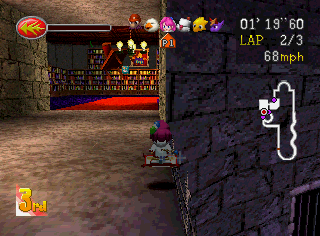
Unfortunately, outside of acing the Grand Prix or grinding through Story Mode, the game hasn't much else to offer. There's a unique Relay Race where you swap characters on every lap, but it effectively reduces the match to a 1-on-1, which is hardly a challenge. The Time Trial doesn't even have built-in staff ghosts, so there's no baseline to pit your skills against. Beating all cups will unlock mirror mode... which is not an even harder league, but instead a toggle buried in the options menu. The game never tells you when you've unlocked anything, by the way, you just have to blunder in there and expect something new!
It's an interesting package and oozes a lot of charm - it's got a great presentation, a lovely mixture of cuddly CG and cutesy storybook artwork, but it feels a bit scant in places. It's an interesting example of how to beef up a game with only ten courses through different modes and gimmickry, but no matter how you dress it, there's not a lot of meat.
It would've been cute to see the game get a proper expansion - more courses, maybe an actual level-up system for your custom characters, who knows. As it stands it's a cute change of pace, a fun relic of SquareSoft's spin-off era, and not a bad little distraction; acing the grand prix kept me busy for a couple of weeks. I just don't expect the multi-player to have the same shelf life as literally any other PS1 racer.
Sonic Rush |
Nintendo DS Jul |

The Retro Pals covered this on their Mascot Friday rankings, and came away with a somewhat divided opinion on it - that game does not make a great first impression, and I can attest to that in my shitty reviews over a decade ago. That and Ryan "BlazeHedgehog" Bloom's constant hailing of the game got me to try it again.
The game kind of demands to be played a very specific way; until you tune into it, it's no doubt going to be obnoxious, but it all comes together once you see its intent:
YOU GOTTA GO FAST
No, like, legit.
The boost function makes you fast and barge through dudes. Destroying Badniks and performing tricks will fill the gauge, and filling it to max will keep it maxed so long as you go fast and keep filling it up. You perform tricks by mashing the A Button after launching off a spring or ramp, and get more points and metre the more you perform in one bound. Pressing R will launch you in the direction you're facing; this helps you reach items or paths otherwise just out of reach, and can help bypass springs or launchers you'd otherwise need to reach a higher level.
The first world is generous with multiple paths and speed-based routes to take, but it doesn't take long before it chucks some wild bottomless pits your way for the simplest of mistakes. The game demands a certain mindset from the player, and if you don't tune into it, it punishes you hard. This is not an all-purpose lackadaisical Sonic romp. It works best if you view it as a score attack challenge. Maximising the points from every launch, moving quickly between setpieces to keep your metre maxed out.
I never gelled with the super-fast play style of Sonic Advance 2 and 3 - it's possible I might warm up to them now, but Rush is the first one where I'd dare say it clicked for me, with a great sense of control over your character's movement and speed. The trick system finally has merit beyond novelty, and paired with the boost system it makes for a really intense and satisfying game.
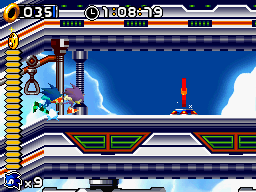
You do need to develop a sixth sense for how the game designs its levels and places traps, though, and when it's appropriate to boost. Night Carnival has you pressing switches to activate platforms and elevators, and they can be easy to miss when you're so inclined to boosting, which will usually fling you into a pit. Altitude Limit is a particular step-up in difficulty, with extended vertical sequences where you're defenceless and have to evade patrolling enemies - and you don't fall down bottomless pits, you hit giant instant-kill lasers instead, which serves the same purpose but only adds insult to injury.
The boss battles are a particularly low point, if not an absurd road block in the early game. Sonic's very first boss is an extremely easy, if needlessly drawn-out fight where the boss hits the ground like a hammer, and you hit the glowing weak point. Easy as! Until it begins rolling along the ground, during which you have to jump at a precise moment otherwise you're knocked off the arena and die instantly.
Most bosses have an instant-kill attack but often fails to telegraph how lethal it is. Paired with the fact every boss takes 8 hits to defeat, and they often waste upwards of thirty seconds before exposing their weak point, they drag on waaaay longer than they really ought to.
The one good fight is the boss of Night Carnival, who periodically lowers itself into harm's way, but can also be attacked at any time by bouncing off an enemy that patrols the arena. That one small gesture makes such a difference. You feel more in control, rather than simply sludging through patterns and dreading an attack that'll catch you off guard and force you to redo the entire fight.
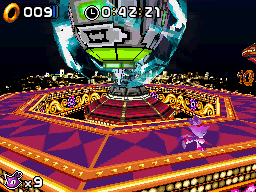
The game's presentation and aesthetics are on point, with a terrific funky soundtrack by Hideki Naganuma and colourful levels, though clarity is an issue at times. The boost mechanic really ties the speedy gameplay together, and a proper per-stage scoring system adds incentive to mastering it and not just throwing the game away once the story's done. Some of the levels do feature needless gimmickry that serves only to kill the momentum, seemingly existing just to show off the dual-screen or 3D effects - the auto-scrolling sequence in Mirage Road or the hang-glider in Altitude Limit, for instance.
Playing the game for score and not putting it down until I got all S-Ranks (except on the boss stages because fuck them) got me to respect the game way, way more than I did years ago. Playing again and again, maxing out your tricks and finding new ways to shave fractions of a second off your time, it's very satisfying to know a stage inside and out and finally earn the rank to show for it. It's still perhaps not exactly what I'd want from a 2D Sonic game, but it's a compelling play and a darn sight better than Advance 2 or 3, or at least what I remember of them. A tough recommend since it's so dang niche, but I'm glad it got through to me in the end.
Taisen! Bomberman |
Mobile Jul |

I wanted to say this is the most fully-featured Bomberman game on mobile - a statement that's hard to dispute when Konami keep delisting all the old games... and now they've gone and delisted this one, so now there's no Bomberman games on mobile. The rotters! The APK even has practically the game data inside it, but the fact there's no online server to connect to means the game is completely inaccessible. Stop me now before I fume about limited-run media and how much crap is gone forever.
I played the game on PC using BlueStacks, so I hardly got the portable, mobile experience the game is designed around, but it was still perfect for quick pick-up-and-play sessions. The Normal Game consists of 100 short levels, all set on a single static screen, and employing a variety of gimmicks that keep you on your toes. The online battle mode was pretty lively even up until its death, and I was guaranteed a match no matter what time of day I played; the gulf in player skill was extremely vast, but no match ever felt drawn-out either because of incompetence or over-competence.
Admittedly the zippy pick-up-and-play philosophy is neutered when the game needs to perform a hefty validation download every time it's booted up, but that's the cost of entry for most online service games these days. It's fine on PC, but none of my mobile devices could manage that.

The game employed a more generous control scheme than the 2014 game; rather than working with a rigid, uncooperative d-pad, the 'control stick' would move to wherever your fingers were on-screen, allowing your hold to drift but still having a handle on where your inputs are. It's hard to explain, but it felt decent.
It apparently recognised some controllers, but not Xbox 360 controllers, natch, so I just had to finagle some wonky system using Xpadder and Bluestacks. It was adequate, but still pretty imprecise, and pressing the bomb button while moving would throw off the inputs entirely. Some players in online mode were clearly playing with super precise controls, and I couldn't compete with my mushy movements.
It was hardly the perfect Bomberman game, but the sheer accessibility was nice. I could manage to find online matches at any time of day, and I could play the Normal Game on loop if I wanted to unlock or upgrade my character skins. If I wasn't playing on a PC and willing to eat up mobile data, I could see it as a game I'd be willing to have on hand to kill a couple of minutes. Aside from Super Bomberman R on Switch, there's no modern outlet for Bomberman on the go, beyond digging out your old handhelds or exploring the digital stores on 3DS or PSP. Welp.
Sonic the Hedgehog (2006) |
Xbox 360 Jul |

I'd been watching Matt and Liam's playthrough around this time, and seeing them bumble through it made me finally get a handle on how Silver's levels are meant to be played. I'd gotten completely stuck on his second level the last time I tried, but I managed to clear the rest of his story in an afternoon!
Silver plays nothing like the traditional Sonic formula, and is almost like a next-gen homage to the pre-development concept of picking up and throwing balls at enemies... only this time it's through telekinesis. It's certainly interesting, and a novel use of the physics engine; you can grab enemy projectiles in mid-air or even the enemies themselves, and throw them to trigger switches, blow up baddies, or destroy terrain. A few rare instances use free-floating objects that you manipulate into use as platforms or battering rams. The devs clearly had fun playing with their physics playground.
As levels, though, they're pretty bad. Where Sonic and Shadow usually have clear setpieces built around their movement and combat abilities, Silver's stages are just meandering. You stroll through tunnels and open plains, employ enemies and debris as projectiles, interspersed either with a trigger to generate platforms or a gate that requires you to kill enemies. They feel like someone dumped a toybox onto the level and left it at that.
They're at their best when they give you the freedom to explore however you want. Kingdom Valley is wide open and full of varied terrain, giving you lots of options to explore - knocking down destructible pillars, zig-zagging through the towers, or just exploiting your float capabilities. I'm pretty sure the second level is still the worst; set entirely on narrow platforms with no clear path, and placing vital springs or pulleys where they're nigh-invisible unless you're looking straight at them.
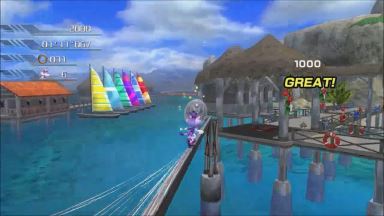
The idea behind Silver's toolset is compelling, but his execution just feels clumsy and sluggish; little hitches like losing momentum every time you float or even land from a jump is such a drag. His passive approach to combat, turning enemies' attacks back against them, is fun in concept, but the spotty hit detection does a number on it.
The fact your projectiles are more likely to bonk into each other than hit their target means there's no satisfaction in amassing swathes of ammo. By the time you unlock the splash damage attack, your best reliable option is simply to stun enemies, pick them up, then put them down again, killing them instantly.
It doesn't help that Silver's buddies are so disparate; Sonic and Shadow's partners all have their merits, but Amy is perhaps the worst in the game. Her acceleration and jumping speed are strangely uncanny, and her sole attack has pitiful range and results in trading hits at the best of times. She also has the ability to turn invisible, which I don't think is ever required for any challenge in the game, ever... but credit where it's due, it gives players something to talk about. What is that for anyway...?!
On the contrary, Blaze is perhaps one of the better characters in the game - she's just as fast as Sonic, but with ridiculous attacks that mop up enemy crowds and launch her skyward, giving her crazy air manoeuvrability. Her few segments can be blazed through in record time, yet her moveset could easily have justified a whole campaign... but the story makes a point of doing absolutely nothing with her, and even kills her off (so to speak) so she doesn't even get an encore in the final chapter. There ain't no justice.
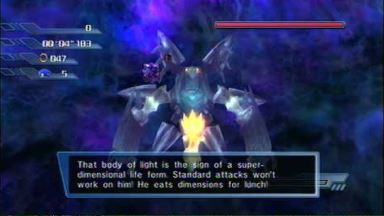
Speaking of... this means I got to play the Final Story for the first time. I don't know how many times I've watched playthroughs of it? I saw RQ87's since-delisted video years ago, then Retsupurae's Wrongplay, then the SGDQ run... it might be four or five times by now. Plus one for beating it myself. Oof. It won't improve your opinion on the game if you made it that far.
It ain't great! The gimmick is reality is slowly eroding, causing black holes to appear that either suck you in and instantly kill you, or hurl bullshit at you. It's pretty stupid. It's especially insufferable for Amy, who can barely outrun the black holes' suction, and Shadow, whose whose stage is littered with narrow platforms and wonky camera angles, in addition to pre-scripted sequences where instant death holes appear right next to where you land. Think fast, asshole!
The final boss is probably the worst of all the 3D ones I've played? Perfect Chaos and Final Hazard were fun compact setpieces (though they can clearly be hurdles for some, having watched the Retro Pals give up at Biolizard). Solaris takes the fighting-dudes-in-space aspect and turns it into something both needlessly complicated and also incredibly brainless. You swap between the three hedgehogs, and each of them has a unique attack that you need to perform in precise order to break Solaris' shell.
The game makes zero indication who's meant to attack when, or even if you're doing it right or wrong. What you do is just hold the R Trigger until the gauge is full or empty, and then press X to attack. That's it. The game didn't tell me this, and there's no reason to even attack without holding R, so what's the point? At no point did it feel epic or incredible. Even the Game Gear games had better final bosses.
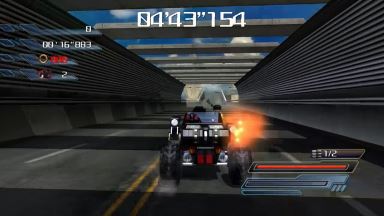
I also dinked about in the towns after beating the game - you can explore the hub worlds at will once the story is complete, allowing you to play all the town missions you missed out on the first time, which is nice. I mostly tried out Shadow's, whose missions looked to be pretty stupid, like the rally race against civilian cars in your G.U.N. buggy. It's wonky as hell, but goes to show the entertaining nonsense they could throw together with all these assets at their disposal!
That's a subject in itself: hub worlds in Sonic games. It's the first time they've had the hardware to support such large locales... but there's absolutely no landmarks to justify it. They're huge and sprawling and needlessly inflated, but none of the characters - not even Sonic! - have the speed to make traversing them any fun. I do wonder if there's a point to having 3D hub worlds in Sonic games, especially since their three attempts (SA1, 06, Unleashed, and probably Advance 3 and Generations if we're counting 2D titles) have often left players disorientated and lost on where to go next.
I liked them in SA1 because they felt like a common ground between all the characters - their levels might have been totally different objectives and play styles, but they could all romp around and use their abilities in Station Square or Mystic Ruins. To be fair, half the fun was in that game's physics engine; launching Sonic off ramps with his spindash, flying around with Tails and Knuckles, or finding ways to glitch Amy or Big into places they shouldn't be.
There's none of that here. For all the fun the game has with its physics engine, none of the characters have satisfying weight or speed to their actions. Jumping feels floaty, the homing attacks has zero weight to it, and there's no way for Sonic or Shadow to reach max speed without a zipper to assist them. SA1 and SA2 had a satisfying sense of weight to the characters that even simple pleasures like jumping off a slope felt good. In Sonic 06 the characters have so little sense of weight, they might as well be bounding boxes sliding across planes. The game has a lot of faults, but this was the biggest heartbreak of all, personally.
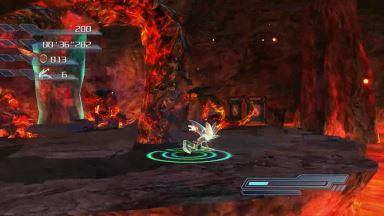
Silver's an interesting experiment. Seemingly a logical path to take when playing around with this fancy-dan physics engine. When it works, picking up projectiles and hurling them back is really satisfying... but more often than not, it's fiddly, cumbersome, and needlessly drawn-out. Scrounging for ammo to throw at dudes just to ding their health by a fraction... it's a pain and a chore and not fun to do. I'd take Silver over the Werehog any day, though.
Ultimately, I'm glad I saw the game through and got it off my back, even if it landed with a wet fart. I think people have been re-evaluating the game in recent years, both because of a new generation of Sonic fans having been reared on it, and also its position as the last relic of the Adventure era, when Sonic wore its ambitions and ensemble cast with pride, even if it didn't do them justice.
It's... it's a bad game. I can't willingly recommend it. But as someone who's still bonkers about Sonic, it's hard not to think about what could've been. Until then, support your local content creators! We'll get a 3D fangame that isn't just a tech demo one of these days!
Sonic Rush Adventure |
Nintendo DS Aug ~ Sep |
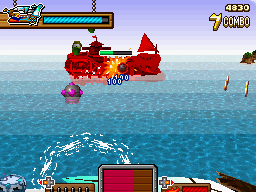
If you wanted more Sonic Rush only with a somewhat inexplicable nautical theme, you got it! If the first game did nothing for you and you're hoping this one will change your mind... yeah, it won't. For every concession it makes to appease potential newcomers, there's just as many foibles to make it that bit more obnoxious.
The elephant in the room is the game's navigation system. The first game's world map has been replaced with an entire ocean to explore, with progress-crucial zones, challenge stages, and story-relevant locations dotted around it. To access them, you have to draw a line across the map and travel via jetski, boat or submarine, each with their own navigational quirks and unique touchscreen mini-game.
Parts of the map can only be accessed by certain vehicles, and you need materials to build these vehicles, which are acquired by getting good ranks on stages. It's a strange bit of busywork, though the requirements are pretty lenient up until the endgame.
The mini-games are actually kind of charming; the jetski is a stand-in for the last game's special stages, while the boat is an auto-scrolling shooting gallery where you blast enemies and obstacles for rings. They can drag on a little, but I really dig the boat - switching between your bullets, bombs and flames depending on what fares best against certain obstacles. It almost makes me hanker for a lightgun game on DS, though I'm sure that'd get tiresome fast.
I'd swapped my DS for a Japanese DSi Lite a while ago, which is better in all regards -- except for games like this that force the language based on the console's region. As such, making progress is a bit of a pain as I can't tell what I'm doing! I would re-enter hubs and talk to people constantly in hopes of advancing the plot, and aside from suspicious dark patches, there's no real clue on the map where the next zone might be.
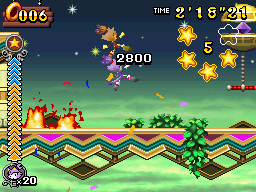
Going back to that "do Sonic games need overworlds?" argument... I'm not sure if this game is a point in its favour. I do enjoy the sheer variety of mini-games, and there's something cathartic about filling out the map and stumbling across hidden islands... but it feels like you're digging through sand just to find the actual Sonic game buried in here.
Speaking of the game: it's nigh-identical to the last one! The core gameplay does feel a little tightened up - the differences between Sonic and Blaze feel more pronounced now that it's quicker to swap between them: Sonic is faster while Blaze has more aerial manoeuvrability with her tricks and hovering. The trick system feels more rounded thanks to the necessity of 'capping off' your tricks with a stunt or pose to get maximum points, meaning there's more to it than just mashing the jump button in mid-air.
The design hasn't improved much otherwise. Perhaps because I've no prior experience with the game, a lot of stage features felt indistinct and hard to determine how you interact with them before you've already crashed into them - the amount of times I stumbled over those vault-orbs...!
For every level that's nice and concise, there's another with some obnoxious, frivolous gimmick, seemingly used to stall for time (and kill the pacing) as it loads the next chunk of level. Coral Cave's minecarts where you can barely see ahead of you, Haunted Ship's 3D stunt springs, Sky Babylon's foreground/background bullshit. I retried Sky Babylon for weeks to get those S-Ranks, and it all came down to wasting as little time on those background sequences! It's unfortunate, because the level design in general feels slightly more 'directed' this time, better conveying what paths there are and with less blind pits to fill into for simple screw-ups.
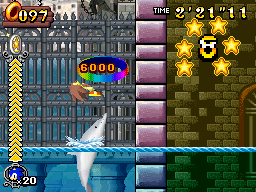
The bosses continue their trail of mediocrity. They do utilise both screens in a unique way each time, and usually have a more interactive method of taking damage, but there's still some real stinkers, including the very first one - a horrible flashback to the dregs of the last game. Kudos to the fight with Captain Whiskers and Johnny for being a unique arena battle of sorts, and for the true final boss just being a shmup.
Despite all its changes, it's about on par with the first one. For the improved level design, there's obnoxious gimmickry. For the joy of finding secrets, there's the tedium of trawling the map. It does arguably offer a more rounded package than the first time, giving more opportunities to chill and take your mind off things with challenge missions, Chaos Emerald races or simply playing mini-games - a healthier way to unwind than just throwing the game down in frustration. If you enjoyed the first one, this'll keep you busy with plenty of new challenges.
Sonic Advance |
Game Boy Advance Aug ~ unfinished |
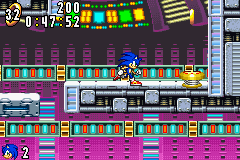
Oh, this one stung. I was struggling to find something big to dig into after Sonic Rush, so I figured I'd revisit my favourite of the Sonic Advance series. This is the one I'm most familiar with and the one I could reliably say was good and I enjoyed... at the time. Now I'm not so sure!
The level design and overall 'feel' is closer to home to the classic Mega Drive games. Tiered levels filled with paths and obstacles, and slowly accelerating just to get moving. It's more a traditional platformer with slopes, momentum, physics, and occasional bursts of high-speed. I seemed to be the only one who liked this game in the mid-2000s, as everyone else ragged on about its sluggish pace...
... and playing it after Rush, yeah, gosh dang, it is slow. Sonic takes a long time to build up speed, and even measures like the spindash don't offer the fix you want. It feels like the game only dishes out speed when it wants to, and often straight into a spike trap.
The levels are actually way bigger than I remember, and I don't think there's any bottomless pits until the fourth zone's second act, which is a kind gesture. I got to Egg Rocket and just got tired of it. I know the later stages got tough, but I don't recall getting this wound up over it. The huge levels might mean something if there was stuff to find, but there's only a single entrance to the special zone in each stage, hidden in some crazily obtuse location that's usually only accessible to Tails. Does this mean I have to reassess the sequels sometime? Will I have to admit Sonic Advance 2 is better than the first one...?!
Metal Slug (PS2) |
PlayStation 2 Aug ~ Sep |
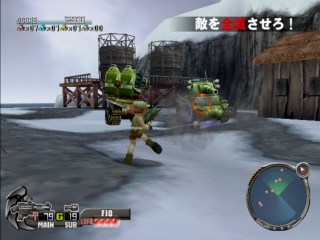
After the unused language options were finally unearthed, I figured I had no excuse to put this off. I'd tried playing the game a couple of times in the past, but it just bounced off me. Most of the game's in English anyway, but those kanji-heavy menus look a bit intimidating, even if you barely interact with them!
The gameplay is... not great. It's not bad, but it's by no means outstanding. Even calling it adequate is dicey. You run through multiple areas in one mission, frequently stopping to eliminate all enemies to remove the barrier blocking your way, and repeat. You rescue prisoners and collect materials that help you unlock customisable parts for the Metal Slug or can upgrade each characters' stats, It tries to maintain the stop-and-go nature of an arcade level, but also feature large areas to explore for secrets and goodies.
It's tolerable, but it rarely shines. The full 3D movement makes aiming precisely infeasible, so you'll be relying on the lock-on constantly, which the game arbitrarily nerfs later on just to keep you on your toes. The camera is stuck firmly behind the character, which makes it hard to get a clear view of the area. Around mission 4 or 5 the game tries to resemble a bullet hell by having lots of infantry fill the area, with tanks raining splash-damage on your location. There's no real finesse to avoiding it, you just keep strafing and using lock-on and hope you don't come a cropper.
The game carries over every single weapon from the arcade games, even oddities like the Iron Lizard and Stone. You carry all weapons in your inventory and toggle between them by holding L2 and pressing Square or Circle, a a system that had me completely floundered on how to change weapons because the game and manual makes no attempt to explain it. It wasn't even until I'd finished the game I realised the same applies to grenades, only you hold R2 instead...!
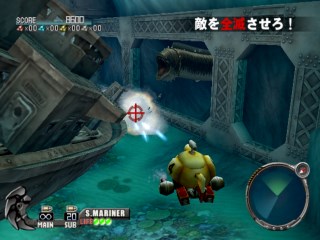
Finding the gun you want out of the dozen in your armoury is a nuisance. I stuck mostly to the knife and handgun to conserve ammo, as most guns are only marginally stronger - the Enemy Chaser and Iron Lizard burn through their entire clip just taking down a couple of tanks.
Some guns have no lock-on and must be manually aimed - this allows you to target foes above or below you, which is otherwise impractical, but it's clearly not something the game is equipped to do. One of the missions won't let you proceed until you take down a plane performing a bombing run, expecting you to bust out the Rocket Launcher or Laser, but I'd sooner spend all my machine gun ammo doing it; hitting it without lock-on was a nightmare.
For a franchise all about vehicles, none of them are very good. The Slug Flyer and Slug Mariner appear in woefully slow-moving auto-scroller segments, where you move the vehicle and reticule separately with the left and right sticks. They're slow and imprecise and easily the most boring stages in the game... but also the only ones I got S-Ranks on, so I've no incentive to ever revisit them.
The Metal Slug... controls like a tank. I mean, that's what it is, but it kind of nullifies the immediate pleasure of riding the vehicle in the arcade games. It has next to no evasive measures, its weapons have no lock-on and are a dickens to aim... I'm lucky to survive one wave of enemies while driving it.
You can swap out its various components - its cannon, vulcan, treads and chassis - with new parts you find throughout the game, and while the visuals and gimmicks are cute, none of them actually make the damn thing fun to use. It eats damage like crazy, and its only saving grace is it's faster than walking, for the ten seconds I inevitably had it before it got wrecked. What a waste.

As not-fun as the game was, there was a certain disassociative zen to just running around, blasting foes, but not really giving a shit. You don't appear to get penalised for dying; I didn't see my rank drop or rewards lost for it. It was a bit like playing dodgy old fangames, where I'm not at all fussed on the gameplay, I'm just moving forward to see what new graphics there are or where the story will go.
It is frustrating, though. The design philosophy of arcade Metal Slug is about simplicity. Simple controls that any player can master, but challenge few can cleanly overcome. 3D game design by definition tends to be more complicated than 2D, but Metal Slug goes from a 3-button shooter into a game that uses every single button and input on the PS2 controller... and still doesn't feel like it gives you the control you need. There's no Y-axis inversion, for a start! Ugh!
Where the game shines is in its story sequences. It's the first Metal Slug game to have its story front-and-centre - the closest we got before were the between-mission communications in Metal Slug: 2nd Mission - and it's kind of dopey and jarring. A strange tale of Morden partnering up with a mysterious organisation whose technology is years ahead of human advancements, but is also carbon dated to billions of years in the past. The whole time the gang are trying to work out what the heck they're up to, why this company's partnering up with an army, and so on.
It's strange and kind of amusing to watch; it's fascinating to see an actual story play out in the Metal Slug universe, complete with full 3D animation and even English voice acting. The voice acting is a bit hit-or-miss and some voices are a little excruciable (poor Fio), but it's just charming to see and hear these characters say more than simple screams. There's some fun little gems in its translation, too; Eri and Rumi have some great lines that look to have come from a capable native English writer.

The story eventually spirals into straight-up anime bullshit involving ancient civilisations, a giant dome of flesh with faces sprouting from it, and the heroes spouting the importance of friendship and living life to the fullest - a charming little platitude that's a bit lost when the original arcade games took so much pleasure in killing people, with artfully-rendered animations of soldiers torn to shreds or fat people bursting like balloons*. It seems so common across Japanese games that the devs are always itching to write some kind of ridiculous shonen anime story, no matter the source material. Sonic the Hedgehog did it already, The King of Fighters even went that far, so why not Metal Slug?
* I bang on about this, but even Chang from The King of Fighters got this treatment in his crossover appearance! The poor bastard gets it rough in the jokey 4-koma strips, but I don't think they fuckin' popped the man into nothingness before Metal Slug Defense. If you surpass a certain body fat ratio does your bodily integrity become forfeit in the world of Metal Slug? Stay tuned for a 400 page fanfiction exploring this and how fate has stacked the deck against body positivity.
I played the game on Easy so I didn't get the full intended challenge, but what I got just felt mushy, especially the bosses. They're often big and arena-filling, yet the camera rarely allows you to see what they're doing, and there's little feedback if you're dealing decent damage or not. The final bosses even counter your attempts at using lock-on, yet using manual-aim weapons didn't seem optimal either. I just couldn't tell what the challenge was meant to be half the time, combat felt so muddy.

It makes me wonder how you'd take another stab at Metal Slug in 3D. Its style of platforming bullet-hell would be hella tricky to translate. The Red Star got close by going top-down, delivering something a little closer to Ikari Warriors on a surface level. I really wanted Lost Planet to have Metal Slug's sense of speed, but it's its own beast. People often grumble about franchises stumbling in the third dimension, but I'm always eager to see them try and attempt to make it work. Metal Slug is very much a 2D arcade game, but I'd love to see those arcade sensibilities make it across somehow.
It was good to finally see the game to the end after all these years, and the charming cutscenes are a bit part of the appeal. The chibi character designs aren't what I'd personally envision, but they suit the low-poly aesthetic; the environments and chunky vehicles make the conversion to 3D very well. Overall, the game just feels mushy. Whatever interesting visuals it presents are lost amidst the fudgy, imprecise gameplay; it's in no way the tight-knit experience of the arcade originals. It's a curious little experiment, one I'm glad got made if just for the novelty of its 3D graphics and gonzo storyline. Would've been nice if it was a better game though. Oh well!
The Reproductive System |
by John Sladek Sep |

A very strange science fiction tale by John Sladek, an author whose murder mystery novel Black Aura I quite enjoyed. His better-known sci-fi stuff is perhaps too heady for my liking - I got a headache reading the first chapter of The Müller-Fokker Effect, and this one I think I soldiered through based mostly on its bombastic pulp sci-fi cover.
In a bid to justify government funding, a toy company manufacture a machine that reproduces itself infinitely, consuming metal and materials to satisfy its need for growth. This, as you'd expect, goes out of control... and the story instead focuses on various other narratives tangentially related to the crisis, including a newspaper journalist who gets drafted into the CIA, a group of casino swindlers whose get-rich-quick scheme is undermined by Las Vegas getting munched, and so on.
It was very clear the likes of Black Aura was played with a lighthearted, tongue-in-cheek atmosphere. In the science-heavy prose of The Reproductive System, the comedy was nigh lost on me until over a third of the way in, and it's an offbeat, often surreal kind of humour, skirting the line between cartoony and outright cruelty at times. It didn't really gel with me a lot of time, if I'll be honest.
It's a book that feels like it's not to be engaged with like a traditional book; you're not intended to bond with any of the characters, nor even root for the safety of mankind. To gank from Darren Goosens' great review, you're intended to "smile ironically with the author. The people in the book are the rats, Sladek is the behavioural scientist, and you are looking over his shoulder." It revels in being an author's work, having the freedom and capacity to inflict whatever it wants upon its characters.
While some threads are so hilariously outrageous you can't help but cackle, a couple feel pointlessly cruel, designed from the word "go" for its climax to be a woeful joke. Among the casino robbers is a woman named Daisy, whose major trait - besides her unexpected aptitude for politico-philosophical debate - is vocally hating the nickname "Daisy Duck".
So when the group enter a hive of dangerous mechanical contraptions, and one comes swinging right for her, the hero cries, "Daisy, duck!" She's too busy giving him an earful to see the danger, and gets splattered between a web of gears and cogs. The moral reasoning is she's with a band of criminals, so we shouldn't feel too bad about her avoidable death, but when there's so many other jerks more deserving of a grisly fate, it felt a strange hand to play.
Reviews systemically praise the book's intelligent writing and keen commentary, and I'll most definitely admit I haven't read a book like it. I'm just surprised I struggled with it all the way to the end, though. I think my tastes are way too simple, and it shoots far above my comprehension.
The Alley God |
by Philip José Farmer Sep ~ Oct |

A collection of three short stories by Philip José Farmer, though I skipped The Captain's Daughter because I got several chapters in and got absolutely nothing from it. The God Business is a strange tongue-in-cheek story about a military operation to fight against the "Brew", a beverage that turns ordinary Americans into flower child peaceniks, some of them even into literal gods of the earth.
A hilarious predicament that's played straight through military procedure, and ends up getting very meta towards the end, revealing the affair is not so much reality as it is allegory. You could argue it dives headfirst up its ass at that point, but still a strange, alluring read.
The big show is the titular story, The Alley Man - an anthropology student researching the plight of a man who claims to be the last surviving Neanderthal, having faced prejudice his entire life and the source of his people's power taken by colonisers. The tone is pretty bleak; the man is alternately self-pitying and self-aggrandising, but holds little power beyond beating the women in his life, yet the student is drawn in by his steadfast devotion to his beliefs.
It doesn't end well for any of them, ending on a decidedly melancholy note, but I loved the raw humanity of it all, so to speak - a culture clash of compassion and cruelty, and all attempts to help one another lead only to a spiral of distrust and hatred. It's bleak and raw and not pleasant reading, but something those eager efforts to aid or achieve just spoke to me for some reason. My personal favourite of the three, but not one I'd recommend in a hurry.
Dead Man's Folly |
by Agathie Christie Oct |
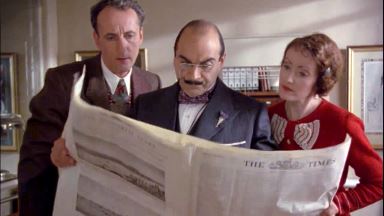
I'm barely going to talk about the book - instead I'm going to talk about the ITV production of Agatha Christie's Poirot, which the parents and I suddenly got hooked on this year. The show ran for over twenty years, and somehow it's only now we took a shine to it!
We've been bouncing around all thirteen series, and David Suchet plays the Belgian detective to perfection; we'd already seen Peter Ustinov and Albert Finney in the role in cinematic productions, but Suchet balances all of his traits to a charming degree - equal parts stuffy and open-minded, haughty yet considerate.
The variety of supporting cast are all terrific, and bouncing between seasons gives all the more opportunity to cherish them equally. And of course, I'm all about that art deco aesthetic. I'll confess to watching TV just to appreciate the interior decorating, and there's always lots to soak in, even if it's something diabolical like pine green bathrooms. I don't care if they're innocent, that should be an arrestable offence.

... which is all the more disappointing to read the original text itself, and it's all just a bit dry. I'm sure that's why Christie's work became so popular, mind; they're extremely easy reads, with no extraneous purple prose or protracted discussions of furnishings unless it's relevant to the case. It's almost all dialogue, making it ample clear where to read the wrongs in each witness' statement. I think I just hoped for something with a bit more meat on its bones. It's so direct that there's barely any art in the words, no prose to get lost in...!
I got halfway through and then skimmed the rest, and I didn't feel like I was missing much. The TV production is pretty close to the text from what I could tell, changing a character or two and adding a more conclusive ending after the book's final scene. If all you want is a murder mystery, I'm sure all of Christie's books deliver... but I've just become a bit spoilt by the lush televised productions, I'm afraid.
Turok: Dinosaur Hunter |
PC (Steam) Dec |
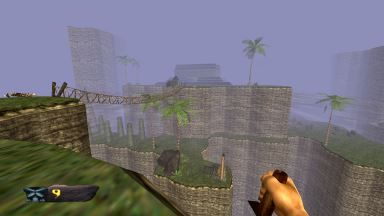
Figured I'd finally give the Steam rerelease a spin; I already played the game in recent memory (well, recent-ish), but I'll take any excuse to revisit the game. Also, maybe I'm a Turok mood. Is this a sign of a sudden obsessive interest? One that may be represented on the site sometime in future? HMMMM.
It's a really solid remaster! It's more than a port, it's been upgraded in an entirely new engine, boasting a bunch of graphical effects and la-di-dah features. There's bloom and depth-of-field and even the option to disable head-bobbing, and the totally impractical sidestep manoeuvre has been removed entirely, sparing me from countless accidental deaths.
The biggest plus, however, is the fact you can actually see things! The impenetrable coating of fog has been given a lot of leeway! It makes the game so much easier to play; I'm not forced to rely on the mini-map to get my bearings, and I feel so much more confident throwing myself off ledges onto secret platforms.

The levels have seen a few small changes from the original, largely for ease-of-use. The climbable nooks in the first level are gone, and the t-rex fight no longer has the arguably-pointless alcoves you could theoretically hide in -- more often than not they served as a dead end to get cooked by its flame breath.
It would've been nice to see some more quality-of-life changes made; the game still only saves at designated save points, with no option for quicksaves or anything like that. The aiming is still as precise as the original, with none of the ludicrously corrective auto-aiming in Turok 2. It's still an old-fashioned hardcore shooter, and although navigation is made easier now, it remains just as much of a relic as it was twenty three years ago. I had a blast playing it again, but that's no doubt the nostalgia talking!
Super Bomberman R |
PC (Steam) Dec |

It's a bit strange living in a world where there was a new Bomberman game and I hadn't played it yet. At first it was on a console I didn't own, then it came to Steam at an exorbitant price, and then it was reduced to £7 or something tolerable, and I figured I had no excuse at this point.
It's another Bomberman game! You run around grids blowing up enemies and doing the usual fare. The normal game is decent enough, with a fair of levels and quirky challenges, and even allows 2-player co-operative for the first time in... twenty years? Oh my god.
There's even per-level objectives like hitting switches, escorting civilians to the safe zone or surviving two minutes against enemy hordes to open the exit. It's a small gesture, but anything remotely new is a fresh sight in traditional Bomberman gameplay.
The other big switcheroo is newly-added verticality. There's slopes and elevations, the ability to place bombs on top of blocks by throwing or punching them, or even getting up there yourself by some trickery. It's... not a feature I'm terribly impressed by. The game already has a clarity issue where its muted colour palette makes it hard to distinguish elevations, and all this appears to add is just another step to throwing bombs.
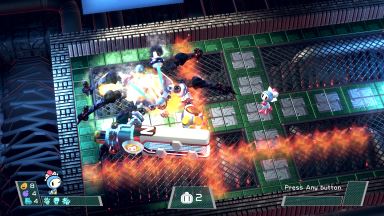
The boss battles kind of blow, too. They're ambitious, some of the grandest fights we've seen in a '2D' instalment, but they don't really gel with the grid-based gameplay. They often float around the arena in ways that don't align with the 4-way movement, and it can be very hard to tell when collision damage takes effect.
They also rely heavily on attacking weak spots to make them vulnerable, similar to Zelda bosses; it spares them from being cheesed by spam tactics, but it makes for battles that feel cumbersome and needlessly drawn-out. They feel like they would have been a better fit in something closer to Bomberman 64, with circular explosions and greater use of 3D space. As is, they're kind of miserable.
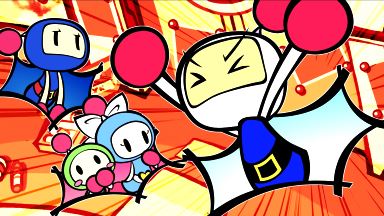
Battle mode is far closer to what you'd expect, and boasts a whole rake of playable characters (including some completely gonzo crossovers - Silent Hill? Halo? WWE's Xavier Woods?!) as well as a Grand Prix, a mode all about team-based matches fighting over checkpoints, collectibles, or capture-the-flag. The computer AI leaves something to be designed in these matches, but it's cool seeing these extra features given the spotlight - too many Bomberman obfuscate their unique modes under tedious menus, so bringing it to player's attention with a giant menu button and even a bombastic introductory cutscene is a nice gesture.
Ultimately... it's another Bomberman game. It's perhaps the most accessible Bomberman package to be found at the moment, available on all modern gaming platform and having enjoyed a year of free DLC in a rare show of good faith from Konami. I value it more as a kind gesture than as a good game; it's an adequate introduction to the series for new fans and idle returnees alike, but as a Bomberman nutcase there's just too many quirks and foibles to make me throw my weight behind it. The 2D artstyle in the cutscenes is adorbs, though. Pity the rest of the game can't match up...!
Shovel Knight: King of Cards |
PC (Steam) Dec |

This is a long time coming: the final chapter of Shovel Knight's DLC campaigns... and the end of the game's development as a whole! Woe! I don't think anyone quite knew what to expect from King Knight; Plague Knight was a terrific reinvention of the formula, if a bit heady to get to grips with at first. Spectre Knight revamped the game into something vaguely resembling Ninja Gaiden, and is perhaps my favourite of the 'instalments'. What could we possibly expect from this pompous joke character?
A somewhat back-to-basics approach, is the answer! Similar to Shovel Knight's simple moveset, King Knight has a shoulder bash that bounces him off whatever he hits, in which state he can then bounce on top of enemies and interact with special objects - drilling through dirt, whisking off of tornadoes, and so forth.
It makes for some crafty puzzle sequences as you contend with walls that can't be bounced off, or objects that react negatively to his spinning state. It took me a long time to get acquainted with it - I think I had some serious brain fog coming back to Shovel Knight after so long - but once I got to grips with it, it's a canny, intuitive ability.
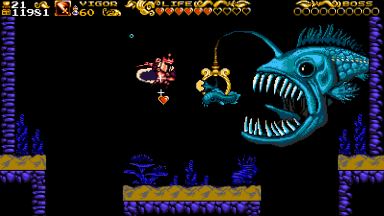
The story serves as a prequel to all the campaigns, before the Enchantress begins her reign and assembles her Order of No Quarter - as such, there's no eight bosses to beat, but instead several dozen smaller levels with only a few essential boss fights. They make for tight, compact challenges that often focus on a specific gimmick, and it's a fun change of pace from the longer length of average levels. Many iconic environments are only seen in one or two stages, and their bosses only fought in optional overworld encounters.
That's perhaps one of the most exciting parts of the game, having followed all the chapters so far: seeing the state of the world before the eventual status quo. It's drenched in lore regarding all the various NPCs and locales from the game's 'present day' state.
Helpful NPCs are fought as brand new bosses and later recruited as allies, as King Knight visits areas otherwise unexplored in the other campaigns. It's really cool interacting with characters in a whole new light, and all the more heartbreaking knowing how the game ends.

We know the whole time that King Knight is an ignorant, self-absorbed buffoon, but by virtue of controlling him, his selfish actions appear heroic through recruiting new friends and uncovering the mystery behind the craze enveloping the kingdom. Only by the end does he take a turn for the jerkass, and you see all the friends and allies you made along the way get betrayed and abandoned, left to lick their wounds and go into hiding until Shovel Knight rises to saves the day.
It's a true testament to the game's prowess not just as a platform game, but in presenting its story and world that I've grown attached to all these seemingly simple NPCs and enemies, who all show their hidden depths in the different campaigns.
A whole new mini-game is introduced with multiple hubs, challenges and secrets related to it: Joustus. A card game where you push cards around to acquire 'gems', shoving enemy cards aside or even blocking passage until the board is filled. I've never played the likes of Final Fantasy VIII's Triple Triad despite how much I've seen people raving over it, so this is totally foreign to me.

I play 2D platformers for the whiz-bang action, so having to stop and think about strategies, more often than not coming to the realisation I'm already screwed, is not quite what I signed up for. It's very satisfying once I figured it out, but I probably haven't got the patience for it; reworking my deck and constantly buying back the cards I've lost is a nuisance. I'm sure there'll be folks who are all over it, and it's an unexpected bonus on top of the main game.
The game itself perhaps isn't as sense-shattering as Spectre Knight's mobile approach to gameplay, but it remains a blast ot play and a fun new reinvention of what we know. It's somewhat melancholy seeing the end of Shovel Knight, especially with the special developer's message for beating all four campaigns... but I've still Shovel Knight Showdown to play, the arena battler with all new playable characters and even unique story modes! My cup runneth over! I can't imagine Yacht Club expected their Kickstarter campaign to result in seven years of development, but hats off to them for delivering tip-top products, and best wishes to them on their future projects.
The Legend of Zelda: A Link Between Worlds |
Nintendo 3DS Dec |
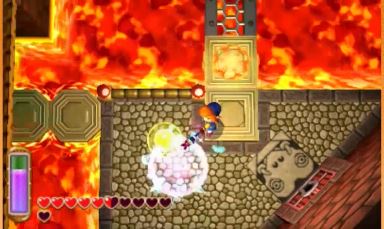
I got in an inexplicable hankering for Legend of Zelda all of a sudden, and figured I might as well plonk down the cash for the one game in years I've been even remotely interested in... and have the console to play it on. I'd like to play Breath of the Wild one of these days, but it can wait.
This is an out-and-out throwback to A Link to the Past, recreating its world and aesthetic in adorable super-deformed 3D, even mimicking the funky tilted perspective in a really unique way. You revisit the major locales, even retreading some of the dungeons in new ways, and explore a brand new dark world, Lorule; its denizens aren't quite as colourful as in the SNES game, but it's got a good variety of setpieces to make up for it.
One of the things that irked me about the much-touted open-ended nature of A Link to the Past, is that it's not so much open-ended as it is entering a dungeon, playing until you get the new item, then buggering off and going elsewhere. That's a perfectly valid way of playing, but that upsets me. You don't drop a job until it's finished! If I got that far, what's stopping me from just finishing the dungeon already?!
So that's why A Link Between Worlds' rental system perked my ears. Although you do acquire passive items like the Titan's Mitt and new armour inside dungeons, the rest of the games tools and equipment are instead rented from your unwanted roommate, Ravio. It takes an hour or so before this feature really hits the spotlight, and even then it's not until you enter Lorule that the game truly opens up.

Once the option is there, it adds a lot more immediate freedom to the game, and kind of takes your mind off the small stuff. All you're going to find in treasure chests are rupees or keys, so there's not the same anxiety of leaving a dungeon without exploring all the rooms, worried I'm missing out on something vital. This did bite me in the ass when I reached the final boss without ever picking up an armour upgrade, and hadn't a baldy notion where it could be, but I made do with fairies and invincibility potions.
In addition to that, Link can now merge into walls and slink across vertical surfaces, allowing him to evade damage, slither through cracks and more. It's a system that sees some really imaginative use, although I tended to overload myself on tools that I often forgot all about it - it's not until the end of the game I realised it's what you need to get the Pegasus Boots... which aren't all that satisfying to use, but oh well. Maybe next time I'll appreciate them more.
I value games that make for quick and breezy handheld play, and this game suits that purpose very well. Dungeons vary in length but can range from 20 minutes to an hour to beat, and always feature a midway warp to make saving partway through that more accessible. It's not far into the game that you get the bell, which makes quick-travel and saving that much easier. The map even allows you to add pins to points of interest, to tag important warp points or stuff to explore later. It's a darn sight easier to hop into than Link's Awakening was back in the day, though that's an unfair comparison.

The open-ended nature does mean the game has no real difficulty curve; some dungeons are tough, some are a cinch, and it's not until the final area that it escalates and expects you to be carrying multiple tools at once. It's perhaps my one major beef with the design, and although the game has a hard mode I've yet to play, I'd love to find out if there's even bonus dungeons that take advantage of this. I doubt it, though!
Also, the story's is somewhat lightweight. This is both worthy of applause and also just a bit of a letdown; it keeps the game fast-paced and breezy, and the dialogue employs some entertaining vernacular ("Make like a piece of fruit and scoot!"). I think two years of people raving about Breath of the Wild and its nuggets of characterisation and lore had gotten my hopes up.
The sages you rescue make such fleeting appearances before they're captured I'd barely any idea who they were; they might as well stay as paintings, their characterisation is so flat. That's not what I'm here for, but it'd be nice for them to entertain the notion. Breath of the Wild had a surplus of characters people unexpectedly fell in love with, and I feel shortchanged! Are 3DS users not good enough to get a buff bird bard?!
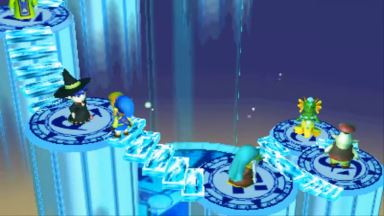
I beat the game in under a week (finished on New Year's Eve, actually! nowhere close to getting all the guff, which should come as no surprise), which is saying something - I end up having to force myself to finish Zelda games; I seem to always run out of steam or get hopelessly lost at some point, but this game I made steady progress each day.
I'm hesitant to declare if I'm back into Zelda or not; there's still a lot of foibles I've little patience for, but it tickled my fancy a lot more than all the other games have done so far. That's saying something! The rental system seems to have driven a wedge in hardcore fans, but it's personally everything I could have asked for, diluted difficulty aside. An impulse buy I'm pleasantly surprised by.